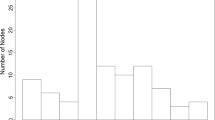Abstract
Traditionally the study of chemical elements has been limited to well-known concepts like the periodic properties and chemical families. However, current information shows a new and rich language that allows us to observe relations in the elements that are not limited to their positions in the table. These relations are evident when reactions are represented through networks, as in the case of similar reactivity of organic compounds sharing functional groups. For the past two decades, it has been argued that network reactions may be considered the core of chemistry. This network, which constitutes the basic set of chemical knowledge, provides the basis for classification and delivers routes to obtain new and known substances. In order to provide an example, we constructed and analyzed a network of chemical elements from the formation of stoichiometric binary compounds, providing to the chemistry, a formal structure of extracting the chemical knowledge. Thus, we explored all possible presence of relationships among elements. Concepts like degree centrality and centralization, the relationships among metals, semimetal and nonmetal classes, blocks, and chemical families were analyzed. We observed that the network structure had a small core set of elements of high reactivity and also a peripheral set of elements of low reactivity. The classes, blocks and families show the following increasing order of reactivity: nonmetals > semimetals > metals; p > s > d > f; and families: boron, carbon, pnictogens, chalcogens, halogens, lanthanoids > other families. This example shows, from the network perspective, that the elements and their classifications exhibit properties such as the reactivity, order, and similarity.









Similar content being viewed by others
Notes
The database of Leal et al. (2012) used in this research consists of 4700 stoichiometric binary compounds, based in the understanding that a binary compound is formed by two different chemical elements, has a chemical bond and there is a change in the chemical nature of the elements. However, this database does not include intermetallic compounds; for this reason, it is interesting to assess the presence of non-stoichiometric and intermetallic binary compounds using network theory. Herein, stoichiometric compounds are just a sample but taking both non-stoichiometric and stoichiometric compounds, a clear landscape could be expected. Results of this approach will be published in a coming paper.
References
Barabási, A., Bonabeau, E.: Scale-free networks. Sci. Am. 288, 50–59 (2003)
Bishop, K.J.M., Grzybowski, R., Bartosz, A.: The core and most useful molecules in organic chemistry. Angew. Chem. Int. Ed. Engl. 46, 5348–5354 (2006)
Carmalt, C.J., Norman, N.C.: Arsenic, Antimony and Bismuth: Some General Properties and Aspects of Periodicity. Springer, London (1998)
Chen, D.Z.: A new method for studying the periodic system based on a Kohonen neural network. J. Chem. Educ. 87, 433–434 (2010)
Connelly, N.G., Damhus, T., Hartshorn, R.M., Hutton, A.T.: Elements. In: Connelly, N.G., Damhus, T. (eds.) Nomenclature of Inorganic Chemistry: IUPAC Recommendations 2005, pp. 51–52. Royal Society of Chemistry, Cambridge (2005)
Dushman, S.: The periodic law: a review of late developments and a revised from of Mendelejeff’s table. Sci. Am. 81, 44–46 (1916)
Fialkowski, M., Bishop, K.J.M., Chubukov, V.A., Campbell, C.J., Grzybowski, B.A.: Architecture and evolution of organic chemistry. Comput. Chem. 44, 7263–7269 (2005)
Firsching, F.H.: Anomalies in the periodic table. J. Chem. Ed. 58, 478–479 (1981)
Gothard, C.M., Soh, S., Gothard, N.A., Kowalczyk, B., Wei, Y., Baytekin, B., Grzybowski, B.A.: Rewiring chemistry: algorithmic discovery and experimental validation of one-pot reactions in the network of organic chemistry. Angew. Chem. Int. Ed. Engl. 51, 7922–7927 (2012)
Grzybowski, B.A., Bishop, K.J.M., Kowalczyk, B., Wilmer, C.E.: The ‘wired’ universe of organic chemistry. Nat. Chem. 1, 31–36 (2009)
Han, J.-D.J., Bertin, N., Hao, T., Goldberg, D.S., Berriz, G.F., Zhang, L.V., Dupuy, D., Walhout, A.J.M., Cusick, M.E., Roth, F.P., Vidal, M.: Evidence for dynamically organized modularity in the yeast protein–protein interaction network. Nature 430, 88–93 (2004)
Hawkes, S.: Semimetallicity? J. Chem. Ed. 78, 1686–1687 (2001)
Hopkins, A.: Network pharmacology: the next paradigm in drug discovery. Nat. Chem. Biol. 4, 682–690 (2008)
International Union of Pure and Applied Chemistry (IUPAC): Periodic table of elements. http://iupac.org/what-we-do/periodic-table-of-elements/. Accessed 20 May 2016
Kowalik, M., Gothard, C.M., Drews, A.M., Gothard, N.A., Weckiewicz, A., Patrick, E.F., Grzybowski, B.A., Bishop, K.J.M.: Parallel optimization of synthetic pathways within the network of organic chemistry. Angew. Chem. Int. Ed. Engl. 51, 7928–7932 (2012)
Leal, W., Restrepo, G., Bernal, A.: A network study of chemical elements: from binary compounds to chemical trends. Match 68, 417–422 (2012)
Masterton, W.L., Slowinski, E.J.: Chemical Principles. W. B. Saunders, Philadelphia (1977)
Maxwell, C.: Physical properties of polonium. I. Melting point, electrical resistance, density, and allotropy. J. Chem. Phys. 17, 1288–1292 (1949)
Nooy, W., Mrvar, A., Batagelj, V.: Exploratory social network analysis with pajek. Cambridge University Press, New York (2006)
Restrepo, G., Mesa, H., Llanos, E.J., Villaveces, J.L.: Topological study of the periodic system. J. Chem. Inf. Model. 44, 68–75 (2004)
Rochow, E.G.: The Metalloids. D. C. Heath and Company, Boston (1966)
Scerri, E.: The Periodic Table: Its Story and Its Significance. Oxford University Press, New York (2007)
Schummer, J.: The chemical core of chemistry I: a conceptual approach. Hyle 4, 129–162 (1998)
Sueur, C., Deneubourg, J.L., Petit, O.: From social network (centralized vs. decentralized) to collective decision-making (unshared vs. shared consensus). PLoS ONE 7, e32566 (2012)
Vernon, R.E.: Which elements are metalloids? J. Chem. Ed. 90, 1703–1707 (2013)
Acknowledgements
R. Suarez thanks Leal et al. for allowing using their database stoichiometric binary compounds, and Nancy Y. Quintero, Joachim Schummer, Eugenio Llanos, Tatiana Suárez and Guillermo Restrepo, for their contributions, valuable discussions and useful reviews given to this research.
Author information
Authors and Affiliations
Corresponding author
Rights and permissions
About this article
Cite this article
Suárez, R.d. The network theory: a new language for speaking about chemical elements relations through stoichiometric binary compounds. Found Chem 21, 207–220 (2019). https://doi.org/10.1007/s10698-018-9319-6
Published:
Issue Date:
DOI: https://doi.org/10.1007/s10698-018-9319-6




